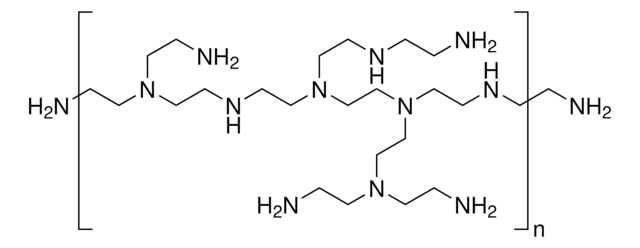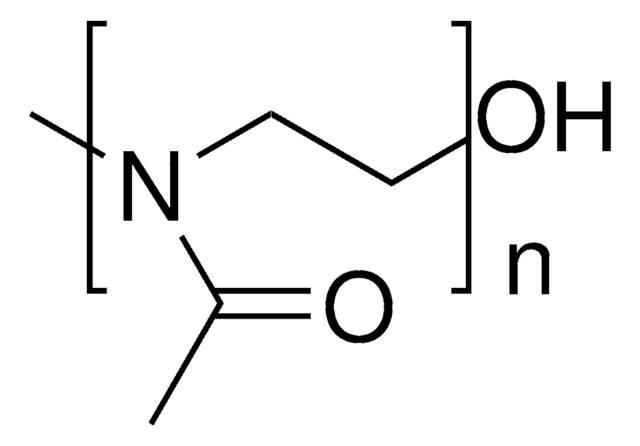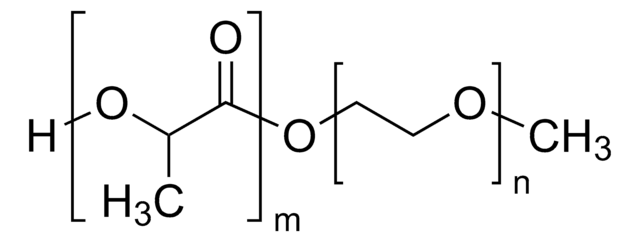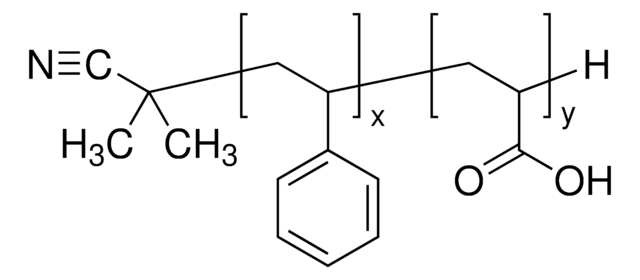908843
Poly(lactide-co-glycolide)-b-poly(ethylene glycol)-b-poly(lactide-co-glycolide)
average Mn (1,600-1,500-1,600), lactide:glycolide 75:25
Synonym(s):
PLGA-PEG-PLGA
Sign Into View Organizational & Contract Pricing
All Photos(1)
About This Item
Linear Formula:
H((C3H4O2)x(C2H2O2)y)m((C2H4O)z)nO((C3H4O2)x(C2H2O2)y)mH
UNSPSC Code:
51171641
NACRES:
NA.23
Recommended Products
form
semisolid
feed ratio
lactide:glycolide 75:25
mol wt
PEG average Mn 1,500 (by NMR)
PLGA average Mn 3,200 (by NMR)
average Mn (1,600-1,500-1,600)
color
white to tan
PDI
≤2.0
<1.1 (Typical PEG PDI )
storage temp.
−20°C
Looking for similar products? Visit Product Comparison Guide
Application
PLGA-PEG-PLGA is an amphiphilic triblock copolymer which can self-assemble into micelles in aqueous medium due to the hydrophobic interactions present in the hydrophobic segments. The PEG segment imparts hydrophilicity and improves the biocompatibility of the copolymer. The PLGA segment forms a hydrophobic core and can solubilize hydrophobic drugs. These copolymers are widely used as nanocarriers for the sustained release of drugs. Also this polymer exhibits thermogelation behavior. When applied in biomedical applications, the temperature responsive nature of the copolymer can be tuned to induce an in situ gelation at physiological temperature to provide controlled drug release. These materials have been explored for biomedical applications as temperature-responsive biodegradable systems for drug delivery, tissue engineering and wound healing.
Storage Class Code
10 - Combustible liquids
WGK
nwg
Flash Point(F)
Not applicable
Flash Point(C)
Not applicable
Choose from one of the most recent versions:
Certificates of Analysis (COA)
Lot/Batch Number
Don't see the Right Version?
If you require a particular version, you can look up a specific certificate by the Lot or Batch number.
Already Own This Product?
Find documentation for the products that you have recently purchased in the Document Library.
Thermoreversible Gelation of PEG-PLGA-PEG Triblock Copolymer Aqueous Solutions.
Jeong B, et al.
Macromolecules, 32(21), 7064-7069 (1999)
Jun Ge et al.
ACS nano, 6(1), 227-233 (2011-11-25)
We describe a new temperature and electric field dual-stimulus responsive nanoparticle system for programmed drug delivery. Nanoparticles of a conducting polymer (polypyrrole) are loaded with therapeutic pharmaceuticals and are subcutaneously localized in vivo with the assistance of a temperature-sensitive hydrogel
Mingxi Qiao et al.
Die Pharmazie, 61(3), 199-202 (2006-04-08)
Biodegradable thermosensitive poly (DL-lactide-co-glycolide-b-ethylene glycol-b-DL-lactide-co-glycolide) (PLGA-PEG-PLGA) triblock copolymers with DL-lactide/glycolide molar ratio ranging from 6/1 to 15/1 were synthesized from monomers of DL-lactide, glycolide and polyethylene glycol and were evaluated for sustained release of bee venom peptide in vitro. The
Chayanin Pratoomsoot et al.
Biomaterials, 29(3), 272-281 (2007-11-03)
Ocular trauma and disorders that lead to corneal blindness account for over 2 million new cases of monocular blindness every year. A popular ocular surface reconstruction therapy, amniotic membrane transplantation, has been shown to aid corneal wound repair. However, the
Byeongmoon Jeong et al.
Biomacromolecules, 3(4), 865-868 (2002-07-09)
This paper reports on the thermogelling, biodegradable polymer formulations based on poly(DL-lactic acid-co-glycolic acid)/(poly(ethylene glycol) graft copolymers for in vivo biomedical applications using animal models. The description includes diabetic control by sustained insulin delivery and cartilage repair by chondrocyte cell
Our team of scientists has experience in all areas of research including Life Science, Material Science, Chemical Synthesis, Chromatography, Analytical and many others.
Contact Technical Service








